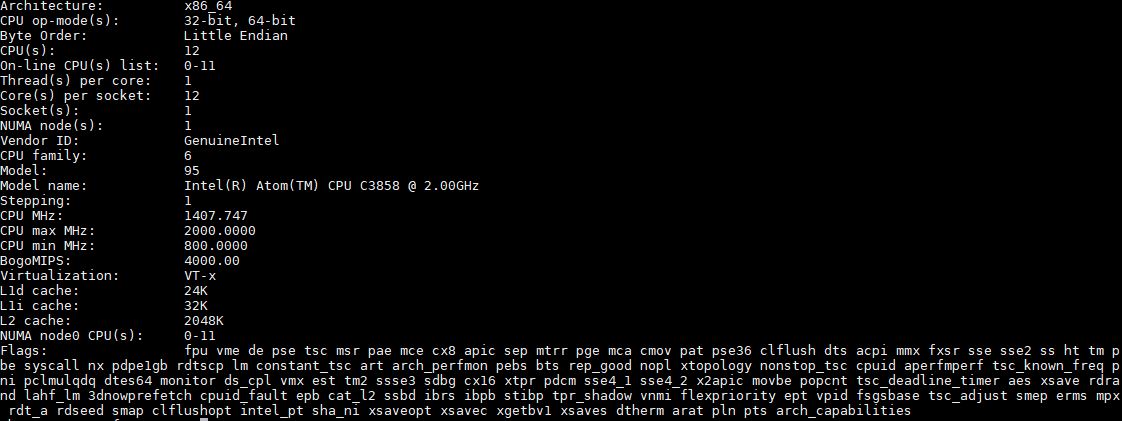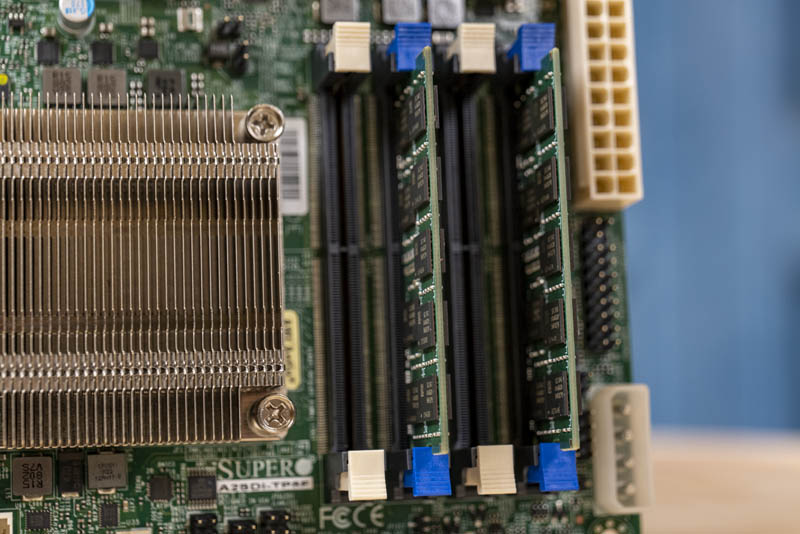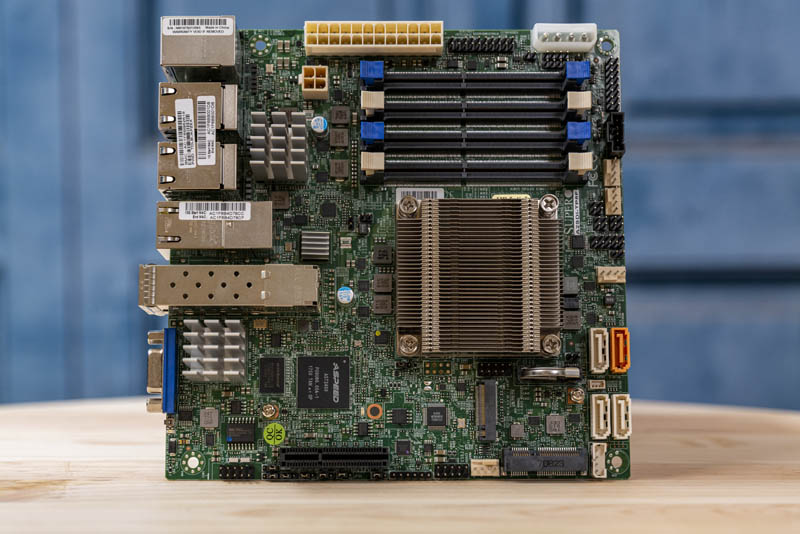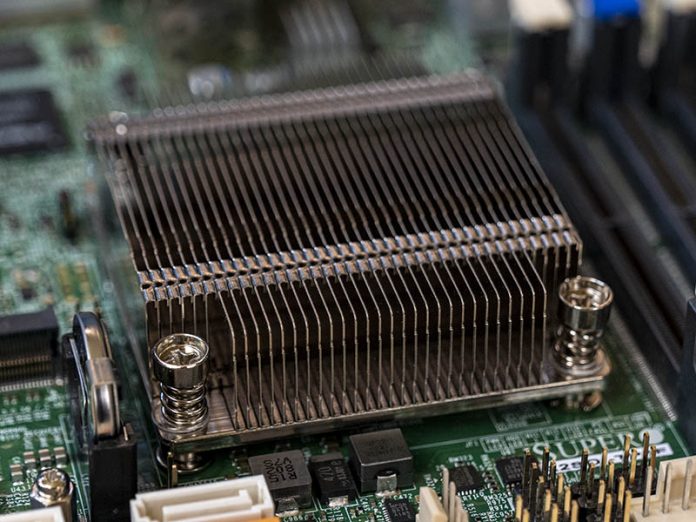Our review of the Intel Atom C3858 is one we could not be more excited about. This is a 12 core part at 25W TDP. That’s the TDP of a few PCH’s these days. In that envelope, we get the full set of 4x 10GbE ports as well as all 20 high-speed I/O (HSIO) lanes that the Atom C3000 series offers. We also get up to 20Gbps of QuickAssist acceleration which makes this a noted, but minor step down from the Intel Atom C3958, yet at a lower cost for those who do not need 16 cores.
Intel Atom C3858 Overview
Key stats for the Intel Atom C3858: 12 cores / 12 threads running at a 2.0GHz clock and a 12MB cache. This is one of Intel’s “Denverton” Atom C3000 SKUs with QuickAssist onboard. This is a $332 list price part that features a low 25W TDP. Here is the ARK page with the feature set.
Here is what the lscpu output looks like for the chips:

If we look at the Intel Atom C3x58 line, we see the 8 core C3758 is $193, this 12 core C3858 is $332, and the 16 core is $449. Aside from the core count jump, the Atom C3858 is a 6W lower TDP part than the Atom C3958. It also has double the QAT bandwidth as the Atom C3758. That gives the chip an upper-midrange capability.
Beyond the cores, one also gets dual-channel RDIMM support. One can use up to 64GB RDIMMs for a total of 256GB of memory at DDR4-2400 speeds. This is more capacity than the Intel Xeon E-2100 and Xeon E-2200 owing largely to RDIMM support. That also lowers the cost to hit, for example, 128GB of memory in the platform.
The quad 10GbE MAC still requires an external PHY for most applications. You will see larger heatsinks on the 10Gbase-T PHYs than on the SFP+ PHYs. These NICs use the Intel 700 series drivers which are available in most OSes natively.
With the SoC packaging, one will notice there is no PCH on the motherboard. This further lowers platform cost, size, power consumption, and complexity. Instead, the Atom C3858 SoC has 20x HSIO lanes. These can be configured to be PCIe or SATA lanes. As a result, one can build very flexible motherboards out of these platforms at the expense of having less total I/O than a platform like the Xeon D-2100 series.
Test Configuration
Here is our basic configuration for this class of CPU:
- Motherboard: Supermicro A2SDi-TP8F
- CPU: Intel Atom C3858 (embedded)
- RAM: 2x 16GB DDR4-2400 ECC SODIMMs
- SSD: Intel DC S3710 400GB
- SATADOM: Supermicro 32GB SATADOM
The CPU itself supports up to 256GB of RAM, in a 4x 64GB configuration. For this class of SKU, that is plenty and our most common configurations are 32GB and 64GB in this range of processor.

Our test platform, the Supermicro A2SDi-TP8F is one that we have wanted to test for many quarters, that review is coming very soon. The platform itself utilizes four DDR4 SODIMM slots with specs limiting it to unbuffered memory. Since the CPU is affixed to the motherboard, we are not going to be able to test higher memory levels with the part, but we have tested other SKUs from the family on other motherboards up to 256GB. The motherboard itself has 4x 10GbE (2x 10Gbase-T and 2x SFP+) along with 4x 1GbE (Intel i350-am4) making for a very interesting networking platform. In addition, there are expansion slots to further customize it.

Since the CPUs are affixed to motherboards directly, we publish our power consumption figures at the platform-level. This is doubly important in this SoC range since other platform components can have a large impact on overall power consumption sometimes more than the primary SoC which is only 25W in this case. Stay tuned for the upcoming review.
Next, we are going to take a look at our Intel Atom C3858 benchmarks, we are then going to focus on power consumption then conclude with our final words on the processors.





I’ve had an issue twice that needed rma for the sfp+ stopped working. One after another when plugged into a Cisco sg500x switch using DAC cables. I’m now using 10gbase-t with transceivers on the switch side.
A server chip similar to renoir could absolutely rock this segment. AMD currently has to focus on the bigger picture, but no doubt as their market share and margins increase, they will have to compete in this segment as well.
@Thomas – totally agree; Renoir’s performance is stunning for the envelope it operates in. Rome definitely pays a power, cost, and density tax for the I/O and memory bandwidth it offers when it tries to compete at lower core counts.
How doe is compare to i3? What is is power consumption?
As others have already sorta touched on, its a bit sad we have been seeing so much movement in the market with Epyc’s release 3 years ago and yet this is the first major release in the segment in quite a while from Intel because AMD has very little pressure here.
One can only hope– It just stinks having to spend so much money relative to the desktop space to hit these performance numbers in these power envelops.
All this tells me is… Buy the Epyc 3251.
I would greatly appreciate further details regarding the RAM that was used for this test. According to the Supermicro website, only one specific 16 GB ECC SODIMM (at 2666 MHz) has been verified to be compatible, but it’s impossible to get hold of. I have tested two different alternatives from Kingston (dual rank and single rank, both 2666 MHz). None worked (systems doesn’t boot).